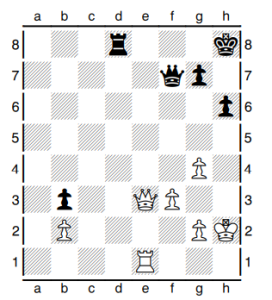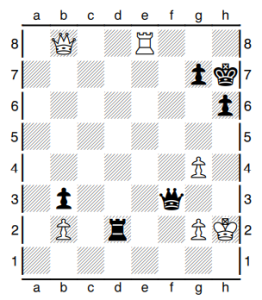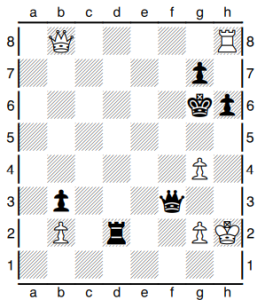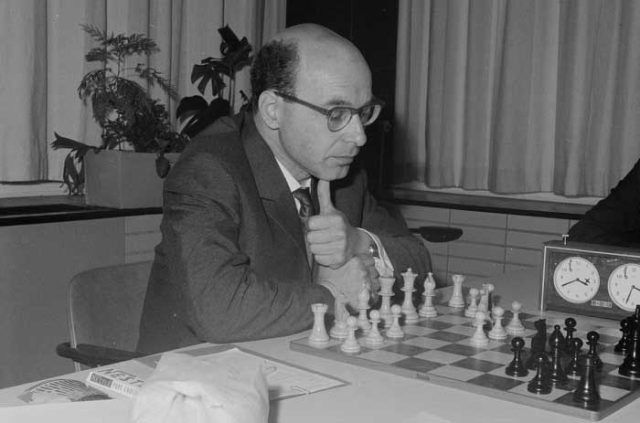In our series ‘The Uncrowned Kings’, today we will learn about David Bronstein who could not win the crown of World Championship but won several strong tournaments, had played innumerable brilliant combinations and wrote several instructive books.
Early Life
David Bronstein was born on February 19, 1924 in Ukraine to Jewish parents. He grew up in a poor family, but started learning Chess at the age of six from his grandfather.
As a youth, Bronstein was trained by the renowned International Master Alexander Konstantinopolsky in Kiev. He finished second in the Kiev Championship when he was only 15, and achieved the Soviet Master title at the age of 16 in 1940. During this time he became a close friend of Issac Boleslavsky, a relationship that developed with time.
After completing high school in spring 1941, his plans to study mathematics at kiev University were interrupted by the Second World War. Shortly after the war’s conclusion, Bronstein joined Leningrad Polytechnical Institute for almost one year.
Judged unfit for military service, Bronstein spent the years of war performing various jobs. Also during the war, his father, Johonon, was unfairly imprisoned for several years but was later revealed that there were no sustantial evidence of committing any crime.
After War Comeback
With the tide turning towards an eventual Soviet war victory, Bronstein was able to once again play some competitive chess. His first top-standard Soviet event was the 1944 USSR Championship where he won his individual game against eventual winner (and soon-to-be world champion) Mikhail Botvinnik.
Bronstein moved to Moscow as the war ended. He raised his playing level dramatically to clinch the third place in the 1945 USSR Championship. This result earned him a place on the Soviet team.
David Bronstein won both his games played on board ten, helping the Soviet team achieve victory in the famous 1945 US vs USSR Radio Chess Match. He then competed successfully in several team matches, and gradually proved he belonged in the Soviet chess elite.
David Bronstein in the World Title Challenger
Bronstein’s first major international tournament success came at the Saltsjobaden Interzonal of 1948. He earned his Grandmaster title in 1950, when FIDE formalised the process. His Interzonal win qualified him for the Candidates’ Tournament of 1950 in Budapest.
Bronstein became the eventual Candidates’ winner over Boleslavsky in a playoff match at Moscow in 1950.
The period 1945–1950 saw a meteoric rise in David Bronstein’s development, as he reached the World Chess Championship challenge match in 1951.
1951 World Championship match- Bronstein vs Botvinnik
In a match wherein the lead swung back and forth several times, the two players tested each other in a wide variety of opening formations, and every game (except the 24th) was played hard for a win.
Bronstein often avoided lines he had favoured in earlier events, and frequently adopted Botvinnik’s own preferred variations. This strategy seemed to catch Botvinnik by surprise. Bronstein claimed four of his five match wins by deep combinational play, winning before adjournment in highly complex fashion.
After 22nd game, Bronstein led by one point but lost the 23rd game and drew the final 24th game. As a result, the title was retained by the defending champion. Unfortunately, David Bronstein never came so close again to win the World Championship.
Later Years
Bronstein represented the USSR at the Chess Olympiads of 1952, 1954, 1956, 1958 and won board prizes at each of them. He lost only one of his 49 games in those events. Along the way he won four Olympiad team gold medals.
It is believed that Bronstein was a victim of Chess politics in the USSR. His stand of supporting Victor Kortchnoi on defection of the latter led to his being banned for over a year between 1976-1978.
Innovative strategies of David Bronstein
Bronstein was one of the most imaginative Chess players and has found many strategic ideas leading to dynamically balanced but sharp positions. Bronstein’s theoretical and practical work in transforming the King’s Indian Defence from a distrusted variation into a popular major system should be remembered as his greatest contribution to Chess.
Before Bobby Fischer, Bronstein and his father-in-law Issac Boleslavsky laid down the basic theory of King’s Indian Defence, which holds absolutely correct even today.
During my small but several interactions with Bronstein during tournaments in the UK and Spain in 1980s and 1990s, I noticed that the great master of King’s Indian was less professional in his approach towards playing Chess for what is commonly known as success. For him success was related only to the creativity over the board and that the result of the game was only secondary.
Bronstein was more of a Chess Artist than a Chess Player. In my opinion, it is this shortcoming in him which often led to making unsound sacrifices in dull positions or avoiding simplification to a boring technical victory. This was the only reason why the Genius couldn’t figure in our series ‘ The World Champion Born On This Date.’
Learn from the Master
Today we will see a little known game of Bronstein, which, in Bronstein’s own opinion, was his best game. The Chess fraternity, apparently, does not seem to think so though, or else the game would have found place in more Chess books.
Bronstein has played several brilliant attacking games. His mysterious manoeuvres leading to unexpected combinations and checkmates have appealed to the world much more. However, if we look at the accuracy level, one may understand the reason why the Bronstein was so pleased with this victory.
Bronstein showed superb technique throughout the game and that the final culmination of the game should occur with an unexpected tactical blow coming out of the blue must have been the most pleasing & satisfying factor for the Chess Artist. The game was played in style of Alexander Alekhine rather than Bronstein’s own style.
David Bronstein – Viktor Kortschnoi [C83]
1.e4 e5 2.Nf3 Nc6 3.Bb5 a6 4.Ba4 Nf6 5.0–0 Nxe4
The Open Morphy variation was one of the most favourite choices of Kortschnoi against the Spanish Game.
6.d4 b5 7.Bb3 d5 8.dxe5 Be6 9.c3 Be7 10.Bc2 0–0 11.Qe2 f5?!
A dubious move, sacrificing a Pawn to neutralize White’s forces without any concrete visualization of the resulting middlegame.
12.exf6 Bxf6 13.Nbd2!
Now Black loses a Pawn by force, without getting an advantage of a Bishop over a Knight, but still there are serious chances of a draw due to inevitable exchange of most of the minor pieces.
13…Bf5 14.Nxe4 Bxe4
14…dxe4 15.Nd2! followed by Nxe4.
15.Bxe4 dxe4 16.Qxe4 Qd7 17.Bf4 Rae8
18.Qc2 Bh4 19.Bg3
A cautious decision.
19…Bxg3 20.hxg3 Ne5 21.Nxe5 Rxe5
White has serious difficulties in converting his advantage to victory, as trying to create a Passed Pawn on the King side could endanger the King safety. If the Queens are exchanged, a draw is the most probable conclusion. Bronstein correctly finds a plan, based on strategic ideas found by legendary Alexander Alekhine.
22.Rfe1 Rd5 23.Rad1 c5 24.a4!
Creating a target on the Queen side is the essence of Alekhine’s plan.
24…Rd8 25.Rxd5 Qxd5 26.axb5 axb5 27.Qe2! b4 28.cxb4 cxb4 29.Qg4 b3
Black has succeeded in exchanging two Pawns on the Queen side but it is not easy to exchange the remaining one. White now combines the weakness of the Black King side and the Black ‘b’ Pawn to create irresistible threats.
30.Kh2 Qf7 31.Qg5! Rd7
31…Rd5? loses to 32.Re8+! Qxe8 33.Qxd5+ Qf7 (To prevent loss of ‘b’ Pawn) 34.Qxf7+ Kxf7 35.g4 Ke6 36.Kg3 Ke5 37.Kf3 Kd4 38.Ke2! with an elementary win.
32.f3 h6 33.Qe3 Rd8 34.g4 Kh8
Kortschnoi

Bronstein
With last few moves, White has dominated the whole board. The logical way to victory is placing Q at e5, & then R at e3 followed by c3 etc. Black will be forced to give up the ‘b’ Pawn eventually. Instead, Bronstein made a serious error here, giving Black a chance to improve the position considerably.
35.Qb6?
35.Qe5! Qf8 36.Kg3 would have won by paralyzing Black’s pieces.
35…Rd2?
In hope of counterplay, Black launches an unsuccessful attack against White King but in the process, he leaves his own King weakened more seriously.
35…Qf4+! 36.Kh3 Rd3!! would have created dangerous counterplay. For example, 37.Qb7? h5! 38.gxh5 Qf5+ 39.Kh2 Qxh5+ 40.Kg1 Rd2 with a forced draw. 41.Qxb3 Qc5+ 42.Kh1 Qh5+ 43.Kg1 Qc5+ 44.Qe3 Qxe3+ 45.Rxe3 Rxb2 The Queen side weakness has been eliminated and a draw is inevitable.
After 35….Rd2 the game continued 36.Qb8+ Kh7 37.Re8! Qxf3?
Black seems to have created dangerous threats against White’s King but Bronstein had foreseen a brilliant combination leading to a forced win. Relatively best was 37…Kg6 , though White wins by force with 38.Kh3!! Rd7 39.Re3! winning the Pawn on ‘b3’.
38…Rxb2? is even worse due to 39.Qe5! Kh7 40.Qe4+ winning Black’s Queen.
Now back to the game.
Kortschnoi

Bronstein
38.Rh8+ Kg6
Black seems to be doing fine but Bronstein had foreseen a beautiful way to win Black’s Queen.
Kortschnoi was hoping for 39.Qe8+? Qf7 40.Qe4+ Kg5 41.Kh3 Qd5 42.Qe7+ Kg6 43.Qe8+ Kg5 44.Qh5+ Kf4 45.Rf8+ Ke3 46.Qxd5 Rxd5 47.Rf3+ Ke4 48.Rxb3 g5 49.Rb6 Ke5 50.Rxh6 Rb5 51.Rg6 Rb3+ 52.g3 Rxb2 53.Rxg5+ Kf6 54.Ra5 Kg6 with a theoretical draw.
Kortschnoi

Bronstein
39.Rxh6+!! 1–0
Black resigned the game in view of the following variations :—
39…. Kxh6 40.Qh8+ Kg6 41.Qh5+ Kf6 42.g5+ Ke7 43.Qxf3 etc.
39…gxh6 is even worse due to 40.Qg8+ Kf6 41.Qf8+ etc.




